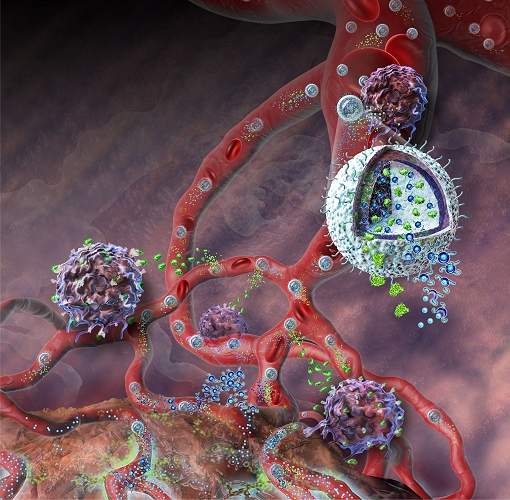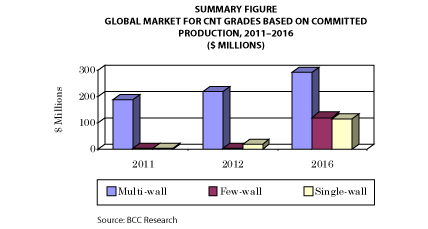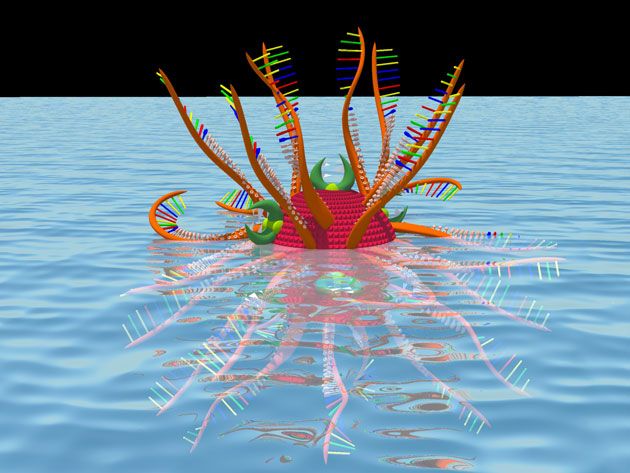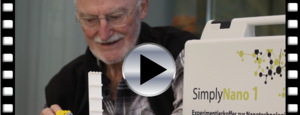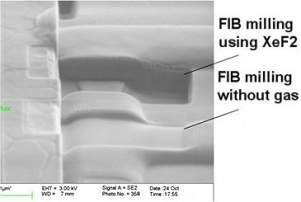 |
Exemplo de estrutura construída com uma estação FIB. [Imagem: Wikipedia/Orsay Physics] |
O Instituto de Física de São Carlos (IFSC), da USP, acaba de receber um "Focused Ion Beam" (FIB), um equipamento utilizado para produzir, processar e caracterizar as propriedades de materiais em escala nanométrica.
O aparelho é considerado uma "estação de nanofabricação" completa e permitirá o desenvolvimento de novas tecnologias, como a dos computadores quânticos. Feixe de íons
O FIB é usado prioritariamente para produção de materiais semicondutores, como os usados em processadores de computador, LEDs, células solares e em toda a eletrônica em geral.
O aparelho de íons focalizados opera de maneira semelhante a um microscópio eletrônico de varredura (MEV), mas com um importante diferencial: enquanto este último se utiliza de um feixe de elétrons para construir imagens de uma amostra, o FIB utiliza um feixe de íons.
Para entender a importância desse avanço, é necessário compreender o funcionamento do feixe de elétrons.
O bombardeamento de elétrons gera energia, ou seja, quando eles são acelerados e concentrados em um feixe, forma-se uma energia muito intensa. Isso produz energia térmica, com altíssimas temperaturas, capazes de fundir qualquer metal (a parte fundida é, posteriormente, transformada em vapor).
Já o feixe de íons, com objetivos similares, é mais pesado que o de elétrons e, por esse motivo, é destrutivo, podendo remover materiais da superfície de amostras, o que permitirá que se esculpa, por exemplo, imagens tridimensionais sob a superfície das mesmas.
"O feixe de íons tanto pode ser usado para construir uma imagem quanto para fazer o processamento de uma amostra," explica Haroldo Araraki, engenheiro do Grupo de Semicondutores do IFSC.
O FIB é capaz de escrever em superfícies em escala nanométrica. Para se ter uma ideia, um fio de cabelo é mil vezes maior do que a escrita que o feixe de íons do FIB pode entalhar.
Nanofabricação de semicondutores
No laboratório de semicondutores, o FIB será utilizado, entre outras coisas, para desenvolver nanomateriais.
"As propriedades dos nanomateriais são diferentes dos micro ou macromateriais", explica o professor Euclydes Marega Júnior. "Quando uma nanoestrutura interage com a luz, por exemplo, ela altera as propriedades ópticas e elétricas do material. Nessa escala de tamanho, a condução elétrica não é a mesma da de um fio de um chuveiro elétrico."
Agora, com a "estação nanométrica" à disposição, os pesquisadores poderão não apenas explorar as propriedades de diferentes tipos de nanomateriais, mas também criar novos.
"Enquanto que, pelo processo tradicional de feixe de elétrons, um dispositivo demoraria um dia todo para ser feito, além de exigir uma grande infraestrutura, com o feixe de íons o dispositivo fica pronto em alguns minutos", afirma Araraki.
O equipamento já é utilizado na indústria de semicondutores em aplicações como análise de defeitos em materiais em escala nanométrica, modificação de circuitos, reparação de máscaras, etc. Saber lidar com esse tipo de maquinário, contudo, pode significar a construção da tecnologia do futuro.
"Produzir corrente elétrica em escala nanométrica é muito mais fácil, por isso produzem-se efeitos que geram ondas eletromagnéticas. Muitos estudos são voltados para a produção de luz, nesses meios, e não eletricidade. Ou seja, em vez de transmitir informações por elétrons, tais informações serão transmitidas por fótons", prevê o professor do IFSC.

 Participam do workshop experts da IAEA e representantes de diversos países da América Latina.
Participam do workshop experts da IAEA e representantes de diversos países da América Latina.

